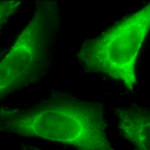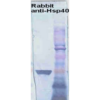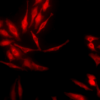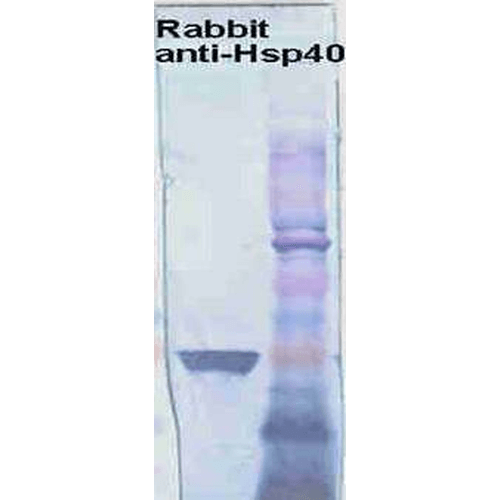Properties
| Storage Buffer | Rabbit Antiserum *Storage buffer may change when conjugated |
| Storage Temperature | -20ºC, Conjugated antibodies should be stored according to the product label |
| Shipping Temperature | Blue Ice or 4ºC |
| Purification | Rabbit antiserum |
| Clonality | Polyclonal |
| Specificity | Detects ~40kDa. |
| Cite This Product | StressMarq Biosciences Cat# SPC-100, RRID: AB_2261861 |
| Certificate of Analysis | 0.5 µg/ml of SPC-100 was sufficient for detection of HSP40 in 20 µg of heat shocked HeLa cell lysate by colorimetric immunoblot analysis using Goat anti-rabbit IgG:HRP as the secondary antibody. |
Biological Description
| Alternative Names | DnaJ (HSP40) homolog subfamily B member 1 Antibody, DNAJ1 Antibody, DNAJB1 Antibody, HDJ1 Antibody, HSPF1 Antibody |
| Research Areas | Cancer, Cell Signaling, Chaperone Proteins, Heat Shock, Protein Trafficking |
| Cellular Localization | Cytoplasm, Nucleus |
| Accession Number | NP_006136.1 |
| Gene ID | 3337 |
| Swiss Prot | P25685 |
| Scientific Background | DnaJ/HSP40 proteins have been preserved throughout evolution and are important for protein translation, folding, unfolding, translocation, and degradation, primarily by stimulating the ATPase activity of chaperone proteins, HSP70s. Because the ATP hydrolysis is essential for the activity of HSP70s, DnaJ/HSP40 proteins actually determine the activity of HSP70s by stabilizing their interaction with substrate proteins. DnaJ/HSP40 proteins all contain the J domain through which they bind to HSP70s. HSP40, also known as HDJ1 (6), is a basic mammalian 40kDa heat shock protein which is not only homologous to the bacterial heat shock protein (DnaJ), but also yeast DnaJ-related proteins such as SCJ1, Sec63/Npl1, YDJ1 and SIS1 (2-5). HSP 40 is inducible by stress including heat after which is moves from the cytoplasm to the nucleus and nucleoli; an intracellular pattern similar to HSC70/HSP70, the mammalian homologues of the bacterial heat shock protein, DnaK (2). |
| References |
1. Melville, M. W. et al. (1997) PNAS USA, 94: 97-102. 2. Hattori, H., Liu, Y-C., Tohnai, I., Ueda, M., Kaneda, T., Kobayashi, T., Tanabe, K., and Ohtsuka, K. (1992) Cell Structure and Function 17: 77-86. 3. Ohtsuka, K. Masuda, A., Nakai, A., and Nagata, K. (1990) Biochem. Biophys. Res. Commun. 166: 642-647. 4. Bardwell, J.C.A., Tilly, K., Craig, E., King, J., Zylicz, M. and Georgopoulos, C. (1986) J. Biol. Chem. 261: 1782-1785. 5. Ohku, M., Tamura, F., Nishimura, S., and Uchida, H. (1986) J. Biol. Chem. 261: 1778-1781. 6. Ohtsuka, K. (1993) Biochem. Biophys. Res. Commun. 197: 235-240. |
Product Images

Immunocytochemistry/Immunofluorescence analysis using Rabbit Anti-Hsp40 Polyclonal Antibody (SPC-100). Tissue: Heat Shocked Cervical cancer cell line (HeLa). Species: Human. Fixation: 2% Formaldehyde for 20 min at RT. Primary Antibody: Rabbit Anti-Hsp40 Polyclonal Antibody (SPC-100) at 1:100 for 12 hours at 4°C. Secondary Antibody: FITC Goat Anti-Rabbit (green) at 1:200 for 2 hours at RT. Counterstain: DAPI (blue) nuclear stain at 1:40000 for 2 hours at RT. Localization: Cytoplasm. Magnification: 100x. (A) DAPI (blue) nuclear stain. (B) Anti-Hsp40 Antibody. (C) Composite. Heat Shocked at 42°C for 1h.

Immunocytochemistry/Immunofluorescence analysis using Rabbit Anti-Hsp40 Polyclonal Antibody (SPC-100). Tissue: Heat Shocked Cervical cancer cell line (HeLa). Species: Human. Fixation: 2% Formaldehyde for 20 min at RT. Primary Antibody: Rabbit Anti-Hsp40 Polyclonal Antibody (SPC-100) at 1:100 for 12 hours at 4°C. Secondary Antibody: APC Goat Anti-Rabbit (red) at 1:200 for 2 hours at RT. Counterstain: DAPI (blue) nuclear stain at 1:40000 for 2 hours at RT. Localization: Cytoplasm. Magnification: 20x. (A) DAPI (blue) nuclear stain. (B) Anti-Hsp40 Antibody. (C) Composite. Heat Shocked at 42°C for 1h.

























StressMarq Biosciences :
Based on validation through cited publications.